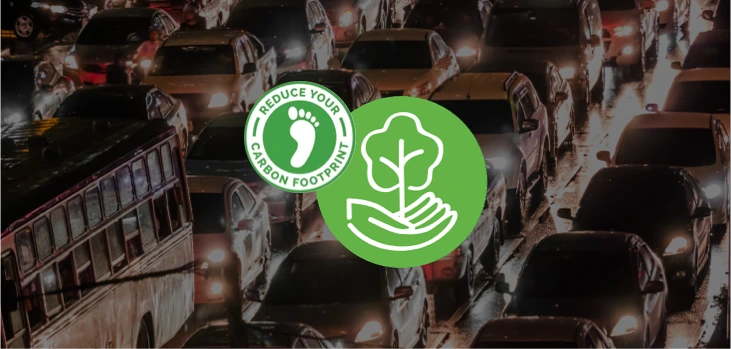
The world is witnessing a seismic shift in how organizations perceive their role in combating climate change and promoting a sustainable future. This shift goes beyond just focusing on profit margins and stock prices and instead emphasizes the importance of responsible corporate citizenship.
Notably, sustainability is a core principle that defines the trajectory of today’s corporate landscape. In this transformative context, corporate carpooling has emerged as a dynamic force, offering an impactful way for companies to reduce their carbon footprints and foster sustainability.
In this blog, I am going to explore the nitty-gritty of this environment-friendly mobility practice, from understanding corporate carpooling to real-world examples of how it’s making waves in the business world. So, without further ado, let’s get started.
What is Corporate Carpooling?
Corporate carpooling is a smart mobility solution that encourages employees within an organization to share rides to and from work, utilizing the same vehicle. This practice enables co-workers, often from the same organization, to travel together, reducing the overall number of vehicles on the road during daily commutes.
In traditional commuting, each employee heads to work solo, driving their own car or using public transportation. It’s a one-person-per-vehicle scenario, while corporate carpooling is a collective effort. It’s about employees coming together, coordinating their schedules, and sharing rides in fewer vehicles using the carpooling app. The result?
-
Lesser parking infrastructure demands
-
Reduced traffic on the roads
-
Lower energy consumption and emissions
-
A greener way to get to work.
So How to Reduce Carbon Footprints via Corporate Carpooling
As we’ve seen, carpooling isn’t just about sharing rides to work; it’s a powerful strategy with multifaceted environmental outcomes. It maximizes the efficiency of vehicle use, minimizes traffic congestion, and encourages eco-friendly transportation choices.
Let’s explore the myriad ways to reduce carbon footprints via corporate carpooling and help foster sustainability.
1. Improved Fuel Efficiency
Carpooling often involves using larger and more fuel-efficient vehicles, such as vans or cars with higher occupancy. By pooling resources and sharing the cost of fuel, employees collectively contribute to reducing the demand for finite fossil fuels and promoting energy conservation.
According to the American Public Transportation Association (APTA), carpooling can save up to 2 billion gallons of gasoline annually in the United States alone. This directly contributes to lower fuel consumption and reduced carbon emissions per person.
2. Encouraging the Use of Eco-Friendly Vehicles
Many organizations that promote corporate carpooling programs also encourage the use of partial zero emission vehicles. In addition, hybrid or electric cars are often favored for their lower emissions and alignment with sustainability goals. This not only reduces carbon footprint but also drives the adoption of greener transportation options.
3. Reduced Traffic Congestion
The most apparent benefit of corporate carpooling is the reduction in the number of vehicles on the road. Instead of every employee driving to work alone in their respective vehicles, carpooling allows several employees to share a ride in a single vehicle. This means fewer tailpipes emitting carbon emissions into the atmosphere.
Fewer vehicles on the road = Reduced CO2 release = Reduction in carbon footprint
According to a study by the Texas Transportation Institute, traffic congestion caused Americans to spend an extra 6.9 billion hours on the road and consume an additional 3.1 billion gallons of fuel in one year.
By carpooling, employees and employers can collaboratively reduce the number of vehicles on the road, especially during rush hours, easing congestion and reducing overall travel time and fuel consumption.
4. Efficient Route Planning
Carpooling often involves planning efficient routes to pick up and drop off passengers. Such optimized routes ensure that carpool members take the shortest and most direct routes to their destination. This means carpool members can minimize the total mileage traveled, resulting in reduced fuel consumption and lower carbon emissions. Furthermore, real-time traffic updates and navigation tools allow drivers to adjust their routes on the fly to avoid traffic jams and road closures, ultimately reducing travel time.
Thus, organizations as well as corporate carpool solution providers can encourage participants to make more sustainable transportation choices. This can lead to a shift in mindset, with individuals becoming more conscious of their environmental impact and choosing eco-friendly commuting to work options.
5. Reduced Need for Parking Space
As the number of vehicles on the road decreases due to carpooling, there is less demand for parking spaces at the workplace. This can lead to reduced construction of parking lots, which often involves environmental disruption and increased impervious surfaces, further contributing to sustainability.
With reduced parking space requirements, organizations can repurpose areas that were originally designated for parking into green spaces. These green spaces not only enhance the aesthetic appeal of the workplace but also provide environmental benefits, such as improved air quality, reduced urban heat island effects, and increased carbon sequestration by trees and plants.
Real-World Corporate Carpool Program Success & Benefits
Several companies, including Google, Salesforce, LinkedIn, Facebook, and SAP, to name a few have experienced significant success with corporate carpooling initiatives.
For example, Microsoft implemented a carpool program at its headquarters in Redmond, Washington, resulting in 10% of its employees participating in shared rides. This led to a reduction of 650,000 miles driven per year and a decrease in carbon dioxide emissions by approximately 340 metric tons annually.
Ideally, carpooling programs align with the broader sustainable development goals and ethical business practices. Here’s how corporate carpooling contributes to corporate social responsibilities and delivers multifaceted benefits.
The Environmental Benefits of Carpooling
The transportation sector is a significant contributor to greenhouse gas emissions, primarily from the burning of fossil fuels in vehicles.
As per the U.S. Environmental Protection Agency, an average passenger vehicle releases about 4.6 metric tons of CO2 annually. This estimate is based on an assumed fuel efficiency of around 22.2 miles per gallon and an annual mileage of 11,500 miles. To put it into perspective, the combustion of one gallon of gasoline produces approximately 8,887 grams of CO2.
Corporate carpooling offers a sustainable solution to reduce these emissions by optimizing vehicle occupancy. Multiple employees sharing a single ride significantly cuts down on the number of vehicles on the road and their associated emissions. It’s a proven low-impact solution with concrete environmental benefits. The below numbers speak to the real-world impact of carpooling.
Studies show that carpooling can significantly cut down carbon emissions. For instance, the United States Environmental Protection Agency (EPA) estimates that carpooling can reduce emissions by up to 30% per passenger. Imagine the positive impact when hundreds or thousands of employees start carpooling. It’s a substantial reduction in our carbon footprint.
But wait, there’s more! Corporate carpooling doesn’t just benefit the planet; it’s a win-win for employees and employers alike.
Advantages for Employees
Employees can save money by carpooling. Carpool buddies help you save on commuting costs by sharing fuel and parking costs while avoiding the full-time car ownership cost. As per the NRDC report, carpooling 20 days a month cuts trips and mileage, lowering driving costs by 40-50%. Furthermore, switching to daily carpooling can save an individual $400–$1,800. Other benefits of carpooling include -
-
Reduced stress levels due to a more relaxed, cost-effective commute
-
Total commuting time savings from high occupancy vehicle lanes
-
Improved social interaction with colleagues
-
Enhanced convenience and flexibility amidst the hybrid work culture
-
Increased productivity and morale
-
Reduced vehicle miles, resulting in cleaner air
Advantages for Employers
Employers also benefit from carpooling as reduced commuting costs and travel time lead to happier and more productive employees. A study by the Harvard Business Review found that employees who carpool are generally more relaxed and focused upon arrival at work. This can translate into increased productivity and reduced absenteeism.
Moreover, a high employee turnover rate can be costly for businesses. Carpooling plays a crucial role in improving employee retention, thereby saving money in recruiting and training new talent.
According to a report by the U.S. Environmental Protection Agency (EPA), employers can save up to $1,600 per year per employee by promoting carpooling, considering reduced parking demand, lower infrastructure costs, and potential tax incentives.
Instead of permitting employees to drive separately, employers can implement a sustainable corporate carpool program where employees share rides with colleagues heading to the same destination. This means employers don’t need as many parking spaces either. For example, in Seattle, a program reduced the number of people driving alone in cars by 11% in 2017.
Reducing vehicle trips through carpooling programs can lead to significant cost savings. This includes capital costs, which range from $15,000 to $45,000 USD per parking space (depending on design and land availability), and annual operational costs ranging between $360 to $2,000 USD per parking space.
Carpooling Tax Benefits for Employers
Participating in a carpool offers financial and tax benefits for employers and employees. Yet, only a few places have state-level carpooling tax credits and commuter tax benefits.
For example, Italy offers a tax credit of up to €10,000 per year for carpooling business managers, within an annual turnover limit of €1 million.
Similarly, in Georgia, employers can get a $25 USD annual tax credit for each employee who uses a federally qualified transportation fringe benefit. Employees must use this commuting option at least 10 times per month to qualify. This credit is available to employers that pay Georgia corporate income tax and provide subsidies for vanpools, or qualified carpool/vanpool parking on or near their business premises.
Conclusion
Corporate carpooling has emerged as a powerful and sustainable solution to combat environmental challenges while fostering a sense of community among employees. By significantly reducing greenhouse gas emissions, cutting fuel consumption, alleviating congestion, and promoting cost savings, carpooling proves to be a win-win for both businesses and the environment.
As more companies embrace corporate carpooling programs, they contribute to a greener and more sustainable environment today and tomorrow. Connect with our team to implement a sustainable carpooling program for your company and make a positive impact on the planet and the well-being of your employees.





Nitin Lahoti is the Co-Founder and Director at Mobisoft Infotech. He has 15 years of experience in Design, Business Development and Startups.